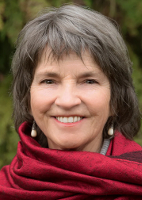
In this Article:
- How conscious breathing techniques can foster emotional and physical healing.
- What does it mean to focus on the exhale to create a deeper connection with ourself?
- How to align our breathing patterns with our body's natural shape and rhythm.
- The role of sound in releasing tension and promoting healing through breath.
- How can you reclaim and practice conscious exhaling to experience a sense of well-being?
Healing Through Breath: Reclaiming Your Inner Calm
by Vickie Dodd.
Our focus with breath begins with the exhale. Let us exhale what we have inhaled. We may notice that we are often held in an inhale.
One hears that the planet is in a state of inhale. Pandemics, crisis, traumas, accidents, illnesses, and so forth can create a condition of holding the breath. Even after the traumas are over, or are no longer an issue, our breath may stay in inhale without our knowing it.
If we exhale, the inhale then easily happens. Remembering that our body knows how to breathe, we then practice conscious breathing to educate and remind ourselves to release, let go, exhale. Our evolutionary capacity is connected to becoming more conscious of the power of our breath.
We have to take time to practice reclaiming our breath on a daily basis.
For my practice I like to lie down, getting out of the field of gravity.
I exhale slowly following the inner terrain of my breath.
"Curved" Breathing vs. Linear Breathing
Our physical body is three-dimensional, an asymmetrical design and shape, with a spiral and curved terrain. We allow our breath to match our interior design. We speak of “matching” the shape of the emotion, the shape of the wound, the direction of the entryway.
In the breath we want to match the inner texture/tapestry of our body. We remove the linear, straight lines from our breath. Linear breathing creates a stress for our breath. We want to match our curved interior shape.
Exploring Sound and Breath Possibilities
Sound releases tension and stuck emotions within breath. I can use my AH sound and move within my chest cavity to massage and caress and relax my thoracic chest. I can direct my AH toward the direction of my front and expand to my sides and into my back. I can allow the AH to fill the space of my chest chamber.
I use my sound to awaken my lungs and thoracic cavity. I direct my hum into my lungs and chest area. The Hum can easily engage and interact with my thoracic and cervical spine, where the ribs insert into the spine and ribcage. The Hum and AH lubricate the spine and ribs.
I pause, take a few conscious breaths, and notice how I now experience my ribs, lungs, and my entire being.
Practice Reclaiming Your Exhale
Practice breathing exercises lying down. We allow gravity to assist us in resting and receiving.
When we are reeducating ourselves or learning a new pattern, it is best to avoid navigating the gravitational field. We can surrender to gravity when we lie down to learn. In this surrendered position, we can more easily place our attention on what our breath is doing.
Things to Remember:
- We do not force our breath. It is not about how big a breath we take or release.
- Our focus is on being conscious, listening, and following our interior terrain with our breath.
- Let us put a curve onto and into our exhale.
- Let our exhale go deeper inside and rest and glide on our inner terrain. No effort. We want to rest and follow our exhale as it glides and swirls and curves itself down toward the pubic bone.
- With our exhale, the ribs start moving down toward the pelvis and hug our lungs. The ribs rest onto our lungs.
- With our inhale our ribs open and expand.
- Let us allow our ribs to dynamically respond and cooperate with the movement of the lungs.
Exercise: Reclaiming Our Exhale
- Get out of the gravitational field; lie down wherever you are comfortable.
- Bring your attention to your breath. Notice what your breath is doing.
- Let your focus be on your exhale. Exhale what you have taken in.
- Let there be a little curve, a little jiggle, a little movement in your exhale. Let your exhale be easy.
- Focus on your ribs. Let your hands rest on your sternum. Feel the weight and sensation of your hands. Let your hands caress your heart.
- The weight of your hands reminds your ribs that they are opening and closing as you breathe. (Oh yes, my ribs get to open and close.)
- Use your hands to touch and guide and release tightness or tension in your ribs.
- Your breath will go anywhere you direct it; it is so cooperative. Act as if your breath can go there.
- Whatever surface your ribs touch, that becomes a teaching place. Your ribs get to open and close against the bed or floor or chair.
- Practice exhaling and inhaling against whatever surface you are touching.
- Feel the dynamic movement and fluidity of your ribs.
Exercise: The Evolutionary Possibility of the Exhale
- Get out of the gravitational field; lie down wherever you are comfortable.
- Bring your attention to your breath.
- Let your focus be on your exhale. Exhale what you have taken in. Consciously reclaim your connection to your breath.
- Let your hands rest on your upper heart and upper chest area.
- Imagine your exhale spiraling into the upper ribs. Take time feeling the small spiral of your breath moving into the upper ribs. Imagine a tiny seahorse on the waves of the breath.
- Let your ribs and heart just rest into your hands.
- Remember your lung lobes; breathe into your upper shoulders, front and back.
- Take time. Relax and go deeper into layers of release and connectedness.
- Your breath starts teaching you the evolutionary possibility of what is ready to unwind and connect.
- Be willing and grateful to participate with the inherent wisdom of your breath.
I Have Nothing to Say
I have nothing to say.
Or, I have too much to say.
Or, it really doesn’t matter what I say.
Or, can I say what I say and be kind?
Yes, that is all that really matters . . .
Can I practice kindness?
Am I willing to practice kindness?
I do know I can more easily practice kindness
if I have taken the time to empty
whatever may be in the way of kindness.
Each day I must be willing to release
that which is burdening me.
I often need to unburden me of me . . .
My “stuff” that I like and that I don’t like . . .
I want “stuff,” I need “stuff,”
what do they think (about me) “stuff” . . .
Unburden the “stuff” of self . . .
So that which is more of essential essence
can be felt and experienced.
I have freedom to release the bondage of the “stuff of self.”
Let me be willing to empty the noise.
Then I may drink in and receive the light
from within and the light from without.
A simple process like running ourselves through a sieve.
Straining the fluoride and chlorine and all the
many microbes and bacteria that water can get filled with,
that which keeps the water from being its essential self.
So, we refine it the same way,
at least in principle, that I empty myself
of that which is not essential
in my water-based system.
Daily, I refine my waters, filter my water
of that which is not of my essence.
Copyright 2024. All Rights Reserved.
Adapted with permission of Findhorn Press,
an imprint of Inner Traditions International.
Article Source:
BOOK: Healing through Sound
Healing through Sound: Awakening Your Audible Body
by Vickie Dodd. Heal and align the body layer by layer through sound healing. This book:
Heal and align the body layer by layer through sound healing. This book:
• Shows how sound, even humming, can change the body’s tissues, rearrange posture, and release long-held emotional trauma and stress;
• Explains how to listen deeply to the body and discover the rhythms of the areas to be treated as well as how to intuit the sounds required for healing;
• Offers practices to help you immediately release tension and explains how to use your voice to release emotional conflicts so your body can naturally heal.
For more info and/or to order this book, click here. Also available as an Audiobook and as a Kindle edition.
About the Author
Article Recap:
This article explores the healing potential of conscious breathing techniques, emphasizing the exhale to release stored emotions and tension. By aligning breath with the body’s natural curves and rhythm, individuals can find a harmonious connection with their inner terrain. Sound enhances this process, helping to lubricate and relax the spine and ribs. Simple breathing exercises done while lying down promote deep relaxation and help reclaim the breath’s natural wisdom.



 Vickie Dodd, M.A., has been a sound healing therapist, bodyworker, workshop leader, musician, and internationally recognized pioneer of healing through sound for more than 50 years. She has collaborated with Don Campbell and is an adjunct faculty member at the Globe Institute in San Francisco.
Vickie Dodd, M.A., has been a sound healing therapist, bodyworker, workshop leader, musician, and internationally recognized pioneer of healing through sound for more than 50 years. She has collaborated with Don Campbell and is an adjunct faculty member at the Globe Institute in San Francisco. 






















